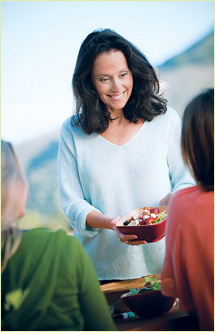

Serving up a freshly made salad. What could be better?
Food can be a very powerful force. Even at this point in my life, I continue to discover the extent of this far-reaching truth. Family values are often shaped around the dinner table, and the way we grow food as a nation is influenced significantly by what we choose to eat … one family at a time.
Since writing my first cookbook, Food to Live By, I’ve been inspired by the many people who told me about their experiences after reading it: They found a new favorite dish, or regularly eat a vegetable they discovered in a recipe, or have a renewed confidence to cook healthier, better-tasting meals from scratch. This book, The Earthbound Cook, was born from my desire to share more delicious recipes, but also to connect our kitchens to everyday actions we can all do to protect the environment. I wanted to combine the pleasures of food with the power of food.
My hope is to offer you three resources at once. First of all, this is a comprehensive cookbook with more than 250 recipes for exceptional main dishes, side dishes, soups, salads, breakfasts, desserts, and more. Second, it’s a helpful reference book full of easy-to-follow tips, cooking primers, and detailed ingredient information. And third, it’s a guide to help you make your kitchen more eco-friendly.
Woven around all these great recipes and cooking information are many interesting and relevant essays and tips to help you learn more about how your food choices and preparation habits affect the environment. I want you to feel empowered when you think about environmental issues, not overwhelmed, so I’ve included tips and suggestions that are easy, effective, and doable on a daily basis. I purposefully drew a circle around the kitchen for the ecological information in this book. Even within that seemingly limited boundary, you’ll be amazed at how many issues there are to cover, and also at how much our actions in the kitchen can affect the planet.
Cooking from scratch with sustainably produced ingredients is one of the most beneficial things you can do for the environment. I hope the recipes in this book will inspire you to cook fresh and delicious foods in your home as often as possible. A conscientious cook who cherishes the endless variety of food produced on this planet while striving to protect it for present as well as future generations is what I call an Earthbound Cook.
I have always felt an instinctive need to be close to growing things—a deep hunger for a connection with nature. During high school I lived in Manhattan, and because of (or maybe in spite of) the stark contrast between city and country life, I longed for fresh air and greenery. This feeling wasn’t something I could clearly describe—I was just conscious of a profound longing to be close to things rooted in the earth.
My chance came in 1984 when I moved to a house on a 2½-acre plot of heirloom raspberry vines and fruit trees in Carmel Valley, California, with my future husband, Drew. We’d just graduated from college, and this was to be an adventure before we moved ahead with our serious goals of graduate school and careers. We had no farming experience, and we didn’t intend to become “real” farmers. But as New York City innocents, we were ripe for nature’s “miracle show”—heirloom raspberry vines flowered white, then produced the sweetest red berries; seeds germinated in rich coastal soil and became delicate baby lettuces, vegetables, and herbs; juicy fruit from our own trees ripened for the picking. We were simply seduced by the land—its natural rhythms, rich flavors, and complex wisdom—and we opened a small roadside stand.
As novice farmers we educated ourselves about organic methods and discovered surprising rewards. Selling the produce we grew in our backyard gave us an immediate and intimate knowledge of the earth, plus the deep satisfaction of producing delicious, healthy food both for ourselves and all the people who stopped by our farm stand to buy raspberries and fresh-baked raspberry muffins. Many of our first customers are still friends today, decades later. Our connection with the land inspired the name we gave our little organic farm and roadside stand: Earthbound Farm. To us, the word earthbound succinctly and powerfully conveyed both the amazing bounty to be appreciated and enjoyed, as well as the undeniable truth that our very sustenance comes from resources that must be nurtured and protected.
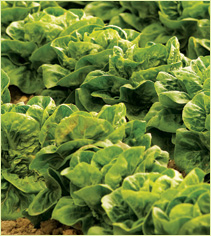
I fell in love with cooking and organic farming at the same time, and to me they are completely intertwined. My cooking was inspired by what we grew on our little farm. Drew and I started growing beautifully colored baby lettuces nurtured by sunshine and just the right amount of coastal fog. We had bumper crops of fruit and vegetables that came in waves, challenging my ability to use everything before it spoiled. At my fingertips were the perfect raw ingredients to create recipes and try out new techniques. I was inspired by the sheer wonder of it all, and I’ve been experimenting with the flavors of fresh-picked organic produce ever since.
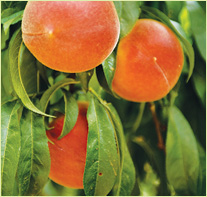
The kitchen is the heart of the home—a perfect place to connect with our enjoyment of food, with each other, and with the very real ecological challenges facing our planet. The kitchen is the center of our food preparation, requiring us to use a lot of energy, water, and cleaning products, and, in turn, generating a lot of waste. Making more mindful decisions about what we eat can have an enormous beneficial impact on the environment. Recent studies have shown that your food choices affect the planet even more than the kind of car you drive.
When Drew and I first started tending our crops, we had no preconceived ideas about the “best” or “correct” way to farm. The berries we inherited had always been grown conventionally, but because almost all farming techniques were new to us, we followed our instincts and looked at everything we did with fresh eyes. As we inspected the cans and bottles of pesticides and chemical fertilizers left in the old shed on the property, we just couldn’t bring ourselves to use them. Instinctively, we didn’t want to touch the pesticides or other chemicals. We didn’t want them on our food. We also couldn’t imagine worrying about chemicals in the air, on our clothes, or tracked into the house on our shoes. We chose to farm organically because we were acutely aware that whatever we did in the field literally followed us into our home.
Ironically, we were not as scrupulous about the chemicals we used inside our home. As conscientious as we were about toxic pesticides and synthetic fertilizers on our crops, we still used chemical cleansers in our home because that’s all we knew. Maybe if we had worked in a factory that made cleansers and had seen firsthand what went into them, we would have had a reaction similar to the one we felt when we came into contact with conventional agricultural chemicals.
But in 1984, neither of us had much of a sense of the environmental impacts of many of our actions beyond farming. I didn’t think twice about using plenty of aluminum foil, paper towels, and plastic wrap. We didn’t worry about whether our oceans were being overfished, or the environmental impact of how our meat was produced. We weren’t particularly aware of the real need to conserve water or energy. And I don’t remember if we’d even heard of global warming or greenhouse gases. But now that I have learned so much more about these issues, I’ve gradually changed many of the things I do in my own kitchen.
My first book, Food to Live By: The Earthbound Farm Organic Cookbook, focused on the many benefits of eating delicious organic foods. Since writing it, I’ve wanted to share more great-tasting recipes and also some of the things I now do in addition to cooking with organic ingredients to make my kitchen more Earth-friendly. I’ve learned a lot about environmental issues and solutions by helping to run Earthbound Farm, which has grown from a backyard garden to the largest grower of organic produce in the country—a little salad-packing line in our living room that grew to produce millions of servings of organic salad every week. The company uses substantial amounts of resources—fuel, electricity, packaging, and water—and we work very hard to find ways to lessen our environmental impact.
There is a lot of environmental information packed into this book, which I’ve organized into five different formats: bite-size Living Green tips; Your Green Kitchen and The Basics boxes, which are fairly short and contain easily accessible facts and tips; essays, which go into more depth about a certain topic; and personal mini essays recounting how I’ve put certain eco-friendly actions to work in my own kitchen. You’ll find everything from the importance of organic farming, to handy shortcuts for minimizing plastic wrap use, to an essay about water conservation, which includes my mom’s stories of her life in pre–World War II Hungary, where every drop of water she used came from a well more than a mile from her home.
In one of my favorite essays, I talk about how cooking with cast-iron is an example of an eco-choice that reaps huge rewards. It’s also a metaphor for the way I look at cooking and the environment. In cast-iron cookware I see the perfect marriage of great-tasting food and an old-fashioned environmental hero that lasts for generations—with no chemical coatings or throw-away mentality behind its manufacture. Cooking with cast-iron is much like farming organically. I feel a “relationship” with my cast-iron as I inspect it to see what it needs after every use, and care for it like an old friend. And like organic soil, my cast-iron gets better over time with proper use and care.
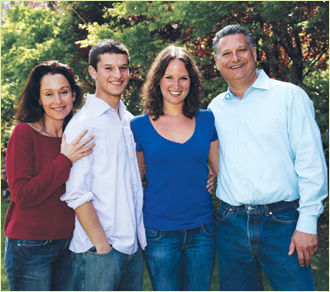
Me with my son Jeffrey, daughter Marea, and husband Drew.
Fresh Strawberry Jam (page 424)
The connection with the food we eat and how it is produced is an intrinsic part of our sense of home and who we are. When I take time to really pay attention to the food I’m eating, I’m still awed to taste the hot summer sun on the skin of a just-picked ripe tomato or the rich soil that sweetens a stalk of broccoli. Eating good food is a pleasure; we should revel in it! Need I mention that homemade usually tastes so much better? It’s also almost always the best way to make sure that ingredients are fresh, healthful, and eco-friendly. Sometimes we get so used to buying prepared foods that we forget it wasn’t so long ago that our grandmothers or great-grandmothers used to make these dishes from scratch as a matter of course.
When we moved to the farm, Drew and I enjoyed creating all sorts of foods we’d previously only bought in stores. These early experiments are still part of our regular routines, and many of the recipes are included here: our bagels, whole wheat bread, pies and jam, just to name a few. I hope you’ll try some of these recipes yourself. Even if you make something only once, your sense of accomplishment can last a lifetime, plus you’ll appreciate it far more each time you buy it in a store.
Learning more about what we eat has many delicious rewards, but it’s also important to realize that the choices we make as consumers affect the way food is produced in this country. I witnessed firsthand how the growth of the organic food movement was truly a consumer revolution. When consumers change what they buy, they are truly changing the world.
As my children grow into adulthood, I’m thinking more generationally. Unlike their city-bred parents, our son and daughter have been surrounded since birth by growing things in a rich stew of cooking experiments and eco-friendly philosophy. I know this heritage will nurture them as they go out in the world, but I also wonder how the flavors of the food they remember from home will follow them.
Now that my daughter, Marea, is in college and cooking for herself in her own first kitchen, I sent her off with one of my beloved, well-seasoned cast-iron pans and some other start-up utensils for her college apartment. What special recipes will she take with her to cook there? Maybe the recipe for the apple pie we made together last Thanksgiving (page 326), weaving an intricate lattice-top crust only to undo it because we forgot to put the pats of butter on top of the filling. Afterward, the crust didn’t look perfect, but the pie tasted delicious, and the laughter and cosmetic imperfections made it an experience we’ll never forget.
Maybe she’ll also take the recipe for the Winter Vegetable Soup (page 26), inspired by the season and my desire to make a special gift for a friend who was convalescing after surgery. I left the recipe on the kitchen counter to use later that evening, only to discover when I came home from work that Marea had made it for our family dinner. I’m not sure who was more thrilled—Marea, who felt a great deal of accomplishment bringing the recipe to life, or me, who was so grateful that a delicious bowl of soup had magically appeared at the end of a long, exhausting day.
I will always remember the day Drew served our son, Jeffrey, his first bowl of Nan’s Tomato Rice Soup (page 4)—a childhood favorite Drew used to eat at his grandmother’s house more than forty years ago, now re-created for this cookbook. As Jeffrey’s face lit up when he tasted the rich broth, the two of them shared an experience that spanned three generations. It makes me smile to imagine Jeffrey’s children enjoying that same soup some day in the future.
It’s never too late or too early in life to learn more about how to enjoy delicious food in ways that help preserve and protect our environment—the bountiful and beautiful planet we have merely borrowed from future generations. Earthbound cooking includes small yet powerful actions that anyone can easily bring to their own kitchen and successfully put into practice one delicious bite at a time. I hope you enjoy these recipes, stories, and eco-tips as much as I enjoyed writing them. Dig in and discover your own inner Earthbound Cook!

Myra Goodman
Carmel Valley, California
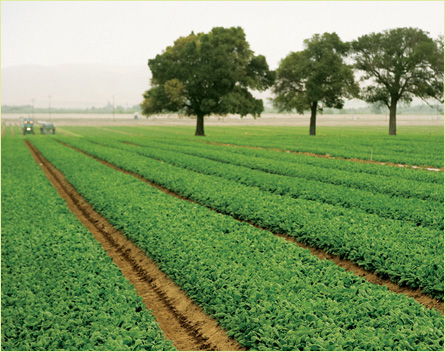
Turn baby spinach leaves into a side dish with garlic and lemon (page 219), a salad with sesame vinaigrette (page 51) and so much more.